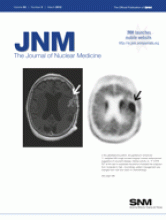REPLY: We appreciate the opportunity to reply to Dr. Bading's letter about our recent publication (1). We agree that the sentence quoted by Dr. Bading—“KFLT was not partial-volume–corrected because it represents a net movement over time of 18F-FLT through tissue compartments, with all time frames equally affected by partial-volume effect, and these are accounted for by the method defining the region of interest (full width at half maximum).”—could be construed as misleading. We have always regarded partial-volume effects as an important limiting factor in any quantitative PET study. We have actually emphasized using partial-volume correction solutions in all our prior publications on static PET of lung cancer with 18F-FDG or 3′-deoxy-3′-18F-fluorothymidine (18F-FLT) (2–6) and have promoted its importance.
In the present study, our static measures of 18F-FLT maximum standardized uptake value were all partial-volume–corrected according to methods we have described and validated (5,6). However, the measures of 18F-FLT flux derived from dynamic 18F-FLT PET that we reported were not partial-volume–corrected. Like static images, individual images of a dynamic PET dataset are affected by partial-volume effects for lesions that are small compared with the reconstructed resolution of the scan. However, contrary to static PET images, for which we have been able to design a first-order correction method (6), we have not been able to correct dynamic datasets for partial-volume effects. The correction used for static standardized uptake value is based on maximum pixel standardized uptake value, which we have found to be superior to methods based on an average standardized uptake value (6). However, because dynamic image bins are short (ranging from 10 s to 10 min) compared with a late static image (30-min-long sum of data acquired from 60 to 90 min after 18F-FLT injection), they are intrinsically noisy. Using a maximal pixel approach within a lung nodule or mass in a set of dynamic images would result in, first, possible selection of different pixel locations from one time frame to the next because of noise and not physiologic differences and, second, amplification of the image noise by time derivatives when solving the compartment model. To minimize this difficulty presented by image noise, we elected to use an approach in which pixels within 50% of the maximum pixel value are selected on a late static summed image (60- to 90-min summed image). This results in the definition of a region of interest that was then applied to each individual image frame of the dynamic dataset for the purpose of compartment modeling and evaluation of the flux constant KFLT. However, although it overcomes noise problems in the dynamic image data, this approach leads to regions of interest of variable shape across lesions. We have not been able to solve partial-volume correction effects for this complex setting, and as mentioned by Dr. Bading, this problem is yet unsolved. That is why our compartment analysis results were not partial-volume–corrected whereas our static measures of 18F-FLT uptake were. Lack of such correction of KFLT is a possible limitation in our reported correlations of KFLT with thymidine kinase-1 and Ki-67. We appreciate that this sentence could have been misunderstood, and we hope that this explanation will clarify the limitations and challenges of the current methodology. Both static and dynamic measures of tracer uptake are affected by partial-volume effects. Accounting for them is important. Developing solutions for partial-volume correction of dynamic PET data is a timely area of investigation.
Footnotes
Published online Jan. 31, 2012.
- © 2012 by the Society of Nuclear Medicine, Inc.







